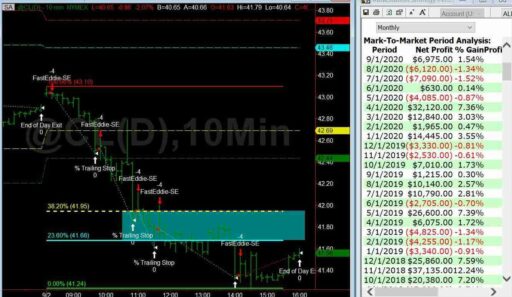As Snowflake Inc. continues to make strides in cloud computing and data analytics, its stock, SNOW, has attracted significant attention from investors and analysts alike. The company’s market dynamics are influenced by a variety of factors, including trading volume, price trends, analyst ratings, and broader economic indicators. This article delves into the current state of Snowflake’s stock, providing a comprehensive understanding of its market position, expert insights, and the various elements that affect its price movements. With the next earnings report on the horizon and a mix of bullish and bearish forecasts, investors are keen to predict the future trajectory of Snowflake’s stock value.
Key Takeaways
- Snowflake’s stock has experienced recent fluctuations, with a notable increase over the past month and significant growth over the past year.
- Technical analysis reveals potential overbought signals, while anticipation builds around the upcoming earnings report.
- Expert insights highlight the importance of distinguishing between short-term market volatility and long-term growth potential.
- The stock price is affected by fundamental factors, market sentiment, economic conditions, and political events, as well as technical support and resistance levels.
- Investors must navigate mixed signals from analysts and tools like the Fear & Greed Index to make informed investment decisions regarding Snowflake stock.
Analyzing Snowflake’s Current Market Position


Recent Trading Volume and Price Trends
Snowflake’s stock has been experiencing notable fluctuations in both trading volume and price trends. The current price stands at $188.28, with a predicted decrease to $167.81, indicating a potential drop of 10.87%. The market sentiment is currently bearish, as reflected by the Fear & Greed Index at 39, suggesting a state of fear among investors.
The trading volume and price trends of Snowflake stock are critical indicators of investor interest and market liquidity.
A closer look at the trading activity reveals a significant focus on a price band between $185.0 and $222.5 over the last three months. Here’s a snapshot of the option volume and open interest for Snowflake:
| Strike Price Range | Calls Volume | Puts Volume |
|---|---|---|
| $185.0 – $222.5 | $706,019 | $104,512 |
This table highlights the disparity between calls and puts, with calls dominating the trading volume, which could suggest a more optimistic outlook among options traders.
Technical Analysis: RSI and Overbought Signals
The Relative Strength Index (RSI) is a momentum oscillator that measures the speed and change of price movements. For Snowflake Inc (SNOW), the current 14-Day RSI is 68.60, which is close to the overbought threshold of 70. This suggests that the stock may be due for a pullback or consolidation period.
The proximity of the RSI to overbought levels could indicate a heightened risk for investors looking to enter the market at the current price.
Traders often combine RSI readings with other indicators, such as moving averages, to make more informed decisions. The 50-Day Simple Moving Average (SMA) for Snowflake stands at $207.13, while the 200-Day SMA is $175.98, indicating a bullish trend over the longer term despite recent volatility.
- Current Price: $188.28
- Price Prediction: $167.81
- Fear & Greed Index: 39 (Fear)
- Sentiment: Bearish
- Volatility: 6.66%
- Green Days: 18/30 (60%)
Anticipation of Upcoming Earnings Report
As the market braces for Snowflake’s earnings report, investors are keenly focused on the company’s financial health and future prospects. The anticipation of these results can significantly sway the stock’s performance, as they provide critical insights into the company’s operational success and potential growth trajectory.
According to Zacks Investment Research, the consensus EPS forecast for the quarter is $-0.49, which reflects analysts’ expectations and market sentiment leading up to the release. This figure is pivotal as it will benchmark the company’s performance against market expectations.
The upcoming earnings report is a moment of truth for Snowflake, where its financials will be scrutinized for signs of robustness or weakness.
Investors should mark their calendars and stay informed on the date of the earnings release, as it is a key event that could influence investment decisions. The last week of February is particularly packed with earnings reports from various technology companies, which could also impact Snowflake’s stock through sector-wide sentiment shifts.
Expert Insights on Snowflake’s Stock Performance


Short-Term Fluctuations vs. Long-Term Growth
When considering the investment potential of Snowflake Inc., it’s crucial to distinguish between short-term fluctuations and long-term growth prospects. Short-term price movements can be influenced by a myriad of factors, including market sentiment, news, and earnings reports. For instance, with Snowflake’s Q4 earnings on the horizon, analysts are closely watching for any deviations from expected results, which could lead to immediate price adjustments.
The anticipation of earnings reports can cause significant short-term volatility. Multiple empirical studies have consistently shown a strong association between trends in earnings estimates and the short-term price movements of a stock.
However, long-term investors are more focused on the company’s fundamentals and growth trajectory. The table below outlines Snowflake’s stock predictions based on its average yearly growth over the past decade:
| Year | Stock Prediction ($) | Growth (%) |
|---|---|---|
| 1 year from now | 322.21 | 71.13 |
| 2025 | 187.28 | -0.53 |
| 2030 | 182.35 | -0.53 |
These figures suggest that while there may be optimism for the short-term, the long-term outlook presents a more conservative growth estimate. It’s essential for investors to balance these perspectives and consider how short-term market dynamics can align or diverge from the long-term growth narrative.
Analyst Perspectives and Contrasting Views
The landscape of financial markets is ever-changing, and nowhere is this more evident than in the contrasting analyst perspectives on stocks like Snowflake. Wall Street analysts forecast that Snowflake Inc. (SNOW) will report quarterly earnings of $0.17 per share in its upcoming release, pointing to a potential pivot point for the stock’s performance.
The disparity between analyst forecasts and proprietary analyses underscores the complexity and subjectivity inherent in stock evaluations. Investors are often faced with a barrage of differing opinions, making the task of discerning the most probable trajectory of a stock like Snowflake a challenging endeavor.
Analyst recommendations can significantly influence market sentiments and, consequently, stock prices. As such, investors must navigate these opinions with strategic foresight, considering a range of factors from these expert insights to fundamental indicators when making investment decisions.
The Importance of Informed Analysis in Investment Decisions
In the realm of investing, informed analysis stands as the cornerstone of sound decision-making. Investors are urged to engage in comprehensive due diligence, align their actions with their risk appetite, and reflect on their long-term financial goals. Keeping abreast of market trends, corporate news, and sector shifts is crucial for crafting informed investment strategies.
The contrasting views among analysts on stocks like Snowflake highlight the ever-changing financial landscape. Investors must navigate these waters with a keen eye on expert insights to make the most of market trends and investment opportunities.
The complexity of the stock market is often distilled into analyst recommendations, which encapsulate extensive research on market conditions, company performance, and economic indicators. It is imperative for investors to scrutinize these recommendations, considering the diversity of opinions and the depth of analysis they represent. Here are key considerations for investors:
- Thoroughly evaluate analyst ratings and price targets.
- Monitor shifts in market sentiment and economic forecasts.
- Balance proprietary analyses with external expert opinions.
Understanding the subtleties behind these recommendations can unlock potential investment pathways and guide strategic foresight in a volatile market.
Factors Influencing Snowflake Stock Price


Fundamental Drivers of Stock Movements
The fundamental drivers of stock movements are critical to understanding why a stock like Snowflake’s behaves the way it does in the market. These drivers are multifaceted and can range from the company’s financial health to broader economic indicators.
- Earnings reports: A primary indicator of a company’s financial status, which can significantly affect investor sentiment.
- Revenue growth: Consistent increases in revenue can signal a company’s expanding business and potential for future profitability.
- Debt levels: High levels of debt can be a red flag for investors, indicating potential financial instability.
- Market share: A company’s control over its market can dictate its competitive edge and influence its stock price.
While stock prices are influenced by a myriad of factors, the core financial metrics remain a central pivot around which investor confidence revolves.
It’s essential to recognize that these elements do not operate in isolation. Economic conditions, for instance, can magnify or mitigate the impact of a company’s financials on its stock price. Investors who grasp the interplay between these fundamental drivers are better positioned to make informed decisions.
The Role of Market Sentiment and Economic Conditions
Market sentiment and economic conditions are deeply intertwined with the performance of stocks like Snowflake. Recent economic data releases have had a significant impact on market dynamics, often influencing the direction of monetary policy in the United States. Speculations around rate cuts or hikes can lead to volatility in equity markets, affecting stocks across various sectors, including technology.
The adjustments in analyst recommendations often reflect the current economic indicators and investor confidence. These recommendations can serve as a barometer for the resilience or vulnerability of corporations like Snowflake amid changing economic conditions. For instance, a lowered forecast for product revenue growth can sway market sentiment, potentially impacting stock prices.
Investors and market watchers are advised to closely monitor these developments. The interpretation of economic data and analyst recommendations can provide valuable insights, guiding investment strategies and market orientations.
Understanding the symbiotic relationship between economic data and market performance is crucial for investors. It allows for a more informed analysis of stocks like Snowflake, which may be susceptible to shifts in market sentiment driven by broader economic trends.
Impact of Political and Interest Rate Changes
The interplay between political events and interest rate fluctuations is a critical factor in the valuation of Snowflake stock. Interest rate changes, in particular, have a direct impact on the cost of capital, influencing investor appetite for growth stocks like Snowflake.
- Political stability can foster a favorable investment climate, while uncertainty can lead to volatility.
- Interest rate hikes typically lead to a reevaluation of stock valuations, as higher rates can dampen economic growth and corporate profitability.
- Conversely, rate cuts are often seen as stimulative, potentially boosting stock prices by lowering borrowing costs and encouraging spending.
The nuanced relationship between political developments and interest rate decisions underscores the importance of monitoring these factors for informed investment decisions.
Market participants must remain vigilant, as these elements can swiftly alter the investment landscape, prompting reassessments of risk and potential returns.
Understanding Bullish and Bearish Forecasts for Snowflake


Market Response to Financial Institution Endorsements
The market often reacts positively to endorsements from esteemed financial institutions. Snowflake’s stock is no exception, with recent upgrades from analysts signaling a vote of confidence in the company’s prospects. For instance, Needham’s upgrade to a target of $265 reflects a bullish outlook, potentially influencing investor sentiment and stock movement.
Following such endorsements, a pattern of increased buying interest can emerge, as investors may adjust their portfolios to align with these new targets. This can lead to a temporary uptick in stock price, as the market digests the implications of the analyst calls.
The adjustments in analyst recommendations are a dance between economic indicators and market performance, offering insights into the resilience or vulnerability of corporations amid fluctuating conditions.
Analyst upgrades and target changes are not only indicators of a company’s performance but also shape the market’s expectations. Here’s a snapshot of recent analyst actions:
| Analyst | Firm | Previous Target | New Target | Rating |
|---|---|---|---|---|
| Brad Reback | Stifel | $200.00 | $235.00 | Buy |
| Joel Fishbein | Truist Securities | $200.00 | $210.00 | Buy |
| Joe Goodwin | JMP Securities | $200.00 | $212.00 | Market Outperform |
| Gregg Moskowitz | Mizuho | $180.00 | $210.00 | Buy |
| Ittai Kidron | Oppenheimer | $220.00 | $240.00 | Outperform |
| Michael Turrin | Wells Fargo | $190.00 | $210.00 | Overweight |
| Mark Murphy | JP Morgan | $170.00 | $200.00 | Overweight |
| Keith Weiss | Morgan Stanley | $215.00 | $230.00 | Overweight |
| Mike Cikos | Needham | $225.00 | $265.00 | Buy |
Stock Target Advisor’s Bearish Analysis
Stock Target Advisor’s proprietary analysis of Snowflake Inc. offers a more cautious perspective on the stock’s future. With 2 positive signals and 6 negative signals, their assessment hints at possible challenges ahead for the company. This bearish outlook is a stark contrast to the more optimistic views held by many analysts.
The disparity in evaluations from different sources highlights the intricate and subjective nature of stock analysis. Investors are reminded to weigh various opinions and indicators before making investment decisions.
The table below summarizes the key signals from Stock Target Advisor’s analysis:
| Positive Signals | Negative Signals |
|---|---|
| 2 | 6 |
While some analysts maintain a strong buy rating and a high average target price for Snowflake, the cautionary stance from Stock Target Advisor underscores the importance of vigilance and the recognition of potential risks that may influence the stock’s path.
Navigating Analyst Ratings and Price Targets
Analyst ratings and price targets are pivotal in shaping investor sentiment and expectations for stocks like Snowflake. Understanding the consensus among analysts can provide a clearer picture of the stock’s potential direction. Recent data indicates a Moderate Buy consensus for Snowflake, with an average price target suggesting a slight downside from the current trading price.
The following table summarizes the latest analyst ratings and price targets for Snowflake:
| Rating | Total | Last 30D | 1M Ago | 2M Ago | 3M Ago |
|---|---|---|---|---|---|
| Bullish | 7 | 1 | 0 | 2 | 4 |
| Somewhat Bullish | 14 | 0 | 2 | 2 | 10 |
| Indifferent | 3 | 0 | 1 | 1 | 1 |
| Bearish | 1 | 0 | 0 | 1 | 0 |
Average Price Target: $216.80
High Estimate: $250.00
Low Estimate: $160.00
The shift in average price target to $216.80, up by 8.85% from the previous target, reflects a positive sentiment shift among analysts.
Investors should pay close attention to revised analyst opinions or price targets, as these adjustments are indicative of the market’s evolving view on Snowflake’s value. The dynamic nature of these ratings requires investors to remain vigilant and informed.
Strategies for Forecasting Snowflake Stock Movements


Tools for Predicting Market Direction
Investors and traders have a suite of tools at their disposal for predicting the direction of Snowflake stock. Technical indicators and chart patterns play a crucial role in forecasting price movements. Among the most utilized technical indicators are the Relative Strength Index (RSI) and Fibonacci retracement levels, which help in identifying overbought or oversold conditions and potential reversal points, respectively.
In addition to technical analysis, candlestick patterns offer valuable insights into market sentiment. Here are some commonly observed patterns and their associated market forecasts:
- Bullish Patterns:
- Hammer
- Bullish Engulfing
- Piercing Line
- Morning Star
- Three White Soldiers
- Bearish Patterns:
- Shooting Star
- Bearish Engulfing
- Dark Cloud Cover
- Evening Star
- Three Black Crows
While these tools provide a framework for analysis, it’s important to remember that no single method can guarantee future stock performance. Investors should use these tools as part of a comprehensive strategy, incorporating both technical and fundamental analysis to make informed decisions.
Identifying Key Support and Resistance Levels
In the realm of stock trading, support and resistance levels are pivotal in forecasting price movements. For Snowflake stock, these levels can be discerned through various technical indicators. The 50-day, 100-day, and 200-day moving averages are particularly telling; they serve as benchmarks for bullish or bearish trends depending on whether the stock price is above or below these lines.
Traders often turn to additional tools such as the Relative Strength Index (RSI) and Fibonacci retracement to gauge potential price directions. These indicators, alongside moving averages, provide a structured approach to identifying key levels where the stock might experience price reversals or breakthroughs.
While no method guarantees absolute precision, understanding and utilizing these indicators can significantly enhance the accuracy of predicting future price actions.
Here’s a snapshot of Snowflake’s recent technical indicators:
| Indicator | Value |
|---|---|
| Current Price | $188.28 |
| 50-Day SMA | $207.13 |
| 200-Day SMA | $175.98 |
| 14-Day RSI | 68.60 |
It’s important to note that the market can be mean reverting even in trending markets, suggesting that resistance and support levels might be more fluid than static.
Interpreting the Fear & Greed Index in Decision Making
The Fear & Greed Index is a crucial barometer for investors, encapsulating the prevailing market emotions that can heavily influence Snowflake’s stock movements. Understanding the index’s signals is key to making informed investment decisions.
When the index leans towards ‘fear,’ it suggests a potential buying opportunity as stocks may be undervalued, while a tilt towards ‘greed’ indicates a market that could be overvalued and due for a correction. Here’s a simplified interpretation:
- Fear: Investors are overly cautious, potentially leading to undervalued stocks.
- Greed: Market confidence may be high, risking overvaluation.
The index’s value is not just a number but a reflection of broader economic health and investor confidence. It is essential to consider the index in conjunction with other market analyses and not as a standalone indicator.
Investors should also be aware of the adjustments in analyst recommendations, as these are reflective of the market’s intricate dance with economic indicators and performance. By integrating the Fear & Greed Index with strategic foresight and nuanced interpretations of market signals, investors can uncover potential pathways to financial growth and stability.
Conclusion
In summary, Snowflake Inc. presents a complex yet intriguing investment landscape, with its stock price influenced by a myriad of factors ranging from market sentiment to fundamental financial indicators. The company’s recent performance and the diverse analyst opinions underscore the dynamic nature of its market position. While some indicators suggest a bullish outlook based on product innovation and market growth, others caution investors about potential risks and volatility. As Snowflake continues to evolve within the competitive cloud computing and data analytics sector, investors should maintain a balanced perspective, informed by both the optimistic forecasts and the cautious analyses. Ultimately, careful monitoring of Snowflake’s strategic moves and market responses will be crucial for those looking to capitalize on the company’s long-term potential for growth and shareholder value.
Frequently Asked Questions
What recent trends have been observed in Snowflake’s stock price and trading volume?
Snowflake Inc.’s stock price has recently seen a modest decline of -3.29% over the past week, with a volume of 520,973 and a price drop of -3.17% to $213.11. Despite this short-term fluctuation, there has been a notable increase of +13.96% over the past month, and a significant appreciation of +45.50% over the last year.
How does the RSI indicator affect the analysis of Snowflake’s stock?
The Relative Strength Index (RSI) is a technical analysis tool that measures the magnitude of recent price changes to evaluate overbought or oversold conditions. For Snowflake, RSI indicators hint that the stock may be approaching overbought territory, suggesting that a trend reversal or price correction might be forthcoming.
What impact does the anticipation of Snowflake’s earnings report have on its stock?
The anticipation of Snowflake’s upcoming earnings report, expected to be released in 7 days, can significantly impact the stock price as investors and analysts adjust their expectations based on potential financial performance revelations.
What factors are influencing Snowflake’s stock price movements?
Snowflake’s stock price is influenced by supply and demand dynamics, driven by fundamental factors such as earnings announcements, new product launches, and market sentiment. Broader economic conditions, interest rates, inflation rates, and political developments also play a crucial role.
How do analysts’ ratings and price targets affect Snowflake’s stock forecast?
Analysts’ ratings and price targets can significantly influence investor sentiment and market expectations for Snowflake’s stock. A strong buy rating or a higher target price from financial institutions can create bullish sentiment, while bearish analyses, like those from Stock Target Advisor, can serve as cautionary signals to investors.
What strategies can investors use to forecast Snowflake’s stock movements?
Investors can use various tools, such as technical indicators and chart patterns, to predict market direction. Identifying key support and resistance levels is also crucial for forecasting price movements, along with interpreting market sentiment indicators like the Fear & Greed Index.





